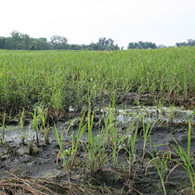VOA慢速英语 2008 1230a
搜索关注在线英语听力室公众号:tingroom,领取免费英语资料大礼包。
(单词翻译)
This is the VOA Special English Agriculture Report. |
| Alfalfa is sometimes grown on marginal land |
We have a question from Jonah Ojowu in Benue State, Nigeria, about a subject we have discussed in the past. Jonah is a postgraduate1 student in soil and water management at the University of Agriculture in Makurdi. He would like information about the management of marginal lands.
"Marginal" lands might have low quality soil. Or they might be on a hillside that rises sharply. Or they might be in an area that gets limited rainfall. In any case, they are the last to be planted under good conditions and the first to be avoided under bad conditions.
But there are uses for marginal lands. Most often they are used as grasslands2 for cattle, sheep or goats. A farmer might use native grasses or non-native seed. Either way, it is important to establish good ground cover to avoid the loss of soil through erosion.
Forage3 crops like clover and alfalfa could be planted. These members of the legume family provide high protein food for grazing animals. They also improve the quality of the soil.
Most plants use up nitrogen. Legumes put nitrogen back into the soil. Forage crops also help reduce erosion of the soil.
But using marginal land for grazing is not as simple as it might sound. Cattle can damage forage crops by eating down to the roots. Also, their weight crushes the soil. That can make the ground too hard for growing.
A way to reduce the damage from overgrazing is to move animals from one field to another. Experts say rotational4 grazing like this is extremely important for marginal land. We will talk more about rotational grazing next week.
Another use for marginal land is for tree crops. Trees help support the soil. They reduce the damaging effects of wind and rain. And they can provide grazing animals with shade from the sun.
Studies have shown that the white pine and loblolly pine are two kinds of trees that grow well on marginal land. They grow fast and provide good quality wood. Another kind to consider is the poplar. And there are slower-growing trees like the black walnut5 that provide a nut crop as well as wood.
Marginal lands need care. Failing to take that care might only make a bad situation worse. But good planning can turn a marginal resource into a highly productive one.
And that's the VOA Special English Agriculture Report, written by Mario Ritter. Archives are at voaspecialenglish.com, where you can also contact us with questions that we might be able to answer on our program. I'm Steve Ember.
 收听单词发音
收听单词发音 




